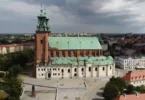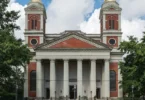Introduction
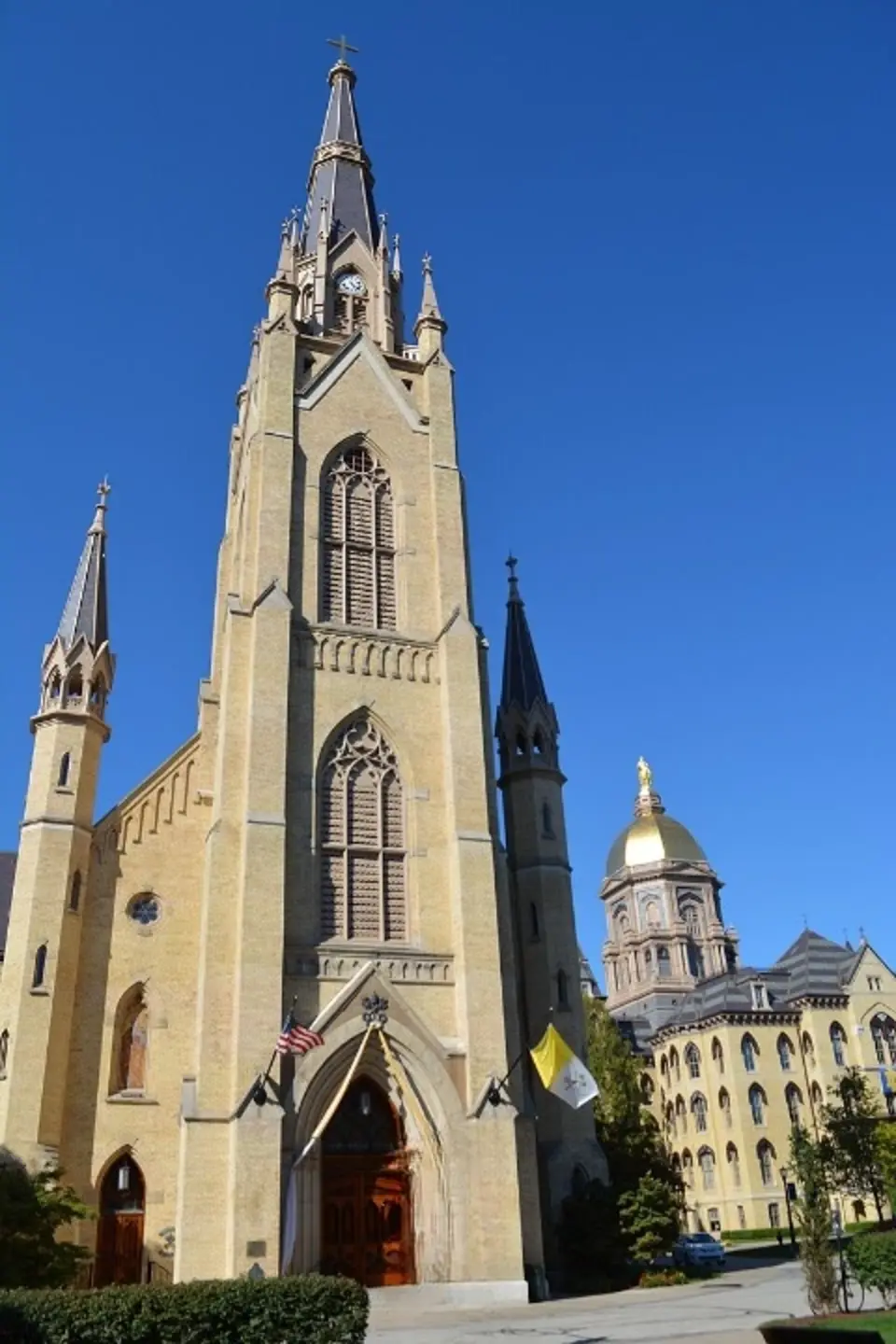
The Basilica of the Sacred Heart in Notre Dame, Indiana, is a Catholic church on the campus of the University of Notre Dame, also serving as the mother church of the Congregation of Holy Cross (C.S.C.) in the United States. The Vatican painter Luigi Gregori worked on the 44 large stained glass windows and murals that make up the neo-gothic church over a 17-year period. The basilica bell tower is 230 feet (70 m) high, making it the tallest university chapel in America. It is a contributing building in Notre Dame’s historic district listed on the National Register of Historic Places. The basilica is a major tourist attraction in Northern Indiana, and is visited annually by more than 100,000 tourists.
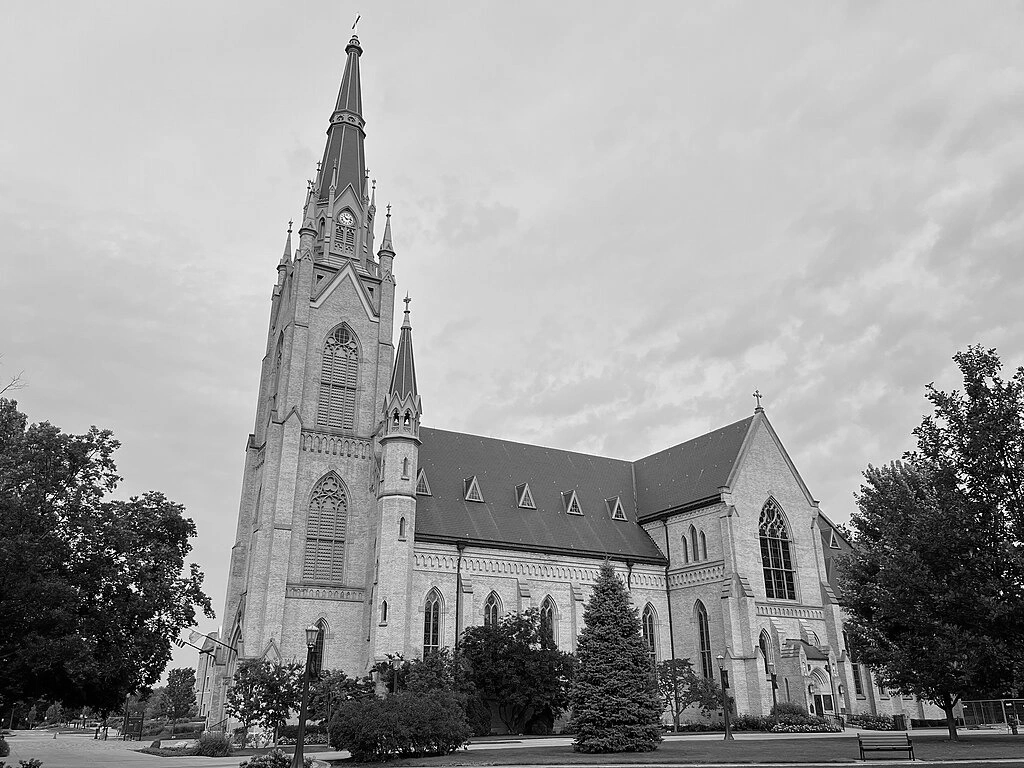
In 1686, Fr. Claude-Jean Allouez, S.J., established the Ste-Marie-des-Lacs mission on the south shore of the St. Mary’s lake, in order to serve the local Potawatomi tribe along with French trappers and settlers in the area. The French Catholic missionaries were expelled by the British from the area following the French and Indian War in 1763, but in 1832 Ste-Marie-des-Lacs was re-established by Stephen Badin and the Log Chapel was built.
The first church
When Rev. Edward Sorin, C.S.C., established the University of Notre Dame, the community held religious services in the small log cabin built by Stephen Badin. This was replaced by a larger log cabin built by Sorin and dedicated on 19 March 1843, slightly to the east of Badin’s log chapel and about the same size.Sorin’s log chapel had become much too small for the needs of the growing college, and despite the lack of funds, Sorin decided to start construction on a proper church building in August 1847. School administrators made the decision to spend $1500 to build a new building. The construction began on May 25, 1848, and the structure was dedicated on November 12, 1848. A year later, on November 11, 1849, the solemn consecration took place with Bishop of Vincennes Maurice de St. Palais presiding. The building was 90 feet long, 38 wide, and 20 high, with twin towers on its front, and was located next to the college building. Father Sorin described the first church: “The style is Greek, with rounded arches. There are three vaults and six columns which produce a very pretty effect. The tribune, which has been built for the use of the Sisters, is elliptical like the sanctuary. It is already enriched with an organ of Mr. H. Erben, and is one of its most precious ornaments, despite being a little weak for the church.” The church was built in Carpenter Gothic. The chancel organ had 1527 pipes and part of the statuary was donated by King Louis Philippe of France. Shortly after the completion of the church, the university added a bell to its tower. The tower and bell were blown to the ground in the spring of 1851 by the wind. In Cincinnati that summer, university administrators purchased a larger bell that weighed 3,220 pounds (1,460 kilograms), blessed it, and then placed it in one of the church towers. In 1852, double spires were built by a local carpenter in exchange for his son’s tuition at the school. The church contained two round stained glass windows purchased from the Carmel du Mans Glassworks of Le Mans. “The Divine Face” was depicted in a third window that the Carmelites gave to Sorin as a gift. Sorin, on a visit to France some years later, purchased a carillon. When the tower spires proved to be insufficient, a separate bell tower was constructed and erected in front of the church. In 1864 the church was the venue of the funeral (performed by Rev. Sorin) of Charles Celestine Sherman, infant son of William Tecumseh Sherman and Eleanor Boyle Ewing Sherman, who died at age five months. The infant was buried in Cedar Grove Cemetery before being moved to the family plot at Calvary Cemetery in St. Louis.
The second (and present) church
The university’s needs soon outgrew the small first church and in spring of 1869 the leaders decided to build a new church dedicated to Our Lady of the Sacred Heart, despite the lack of funds in the school’s treasury. The initial plans, which were drawn by well-known architect Patrick Keely, envisioned a baroque layout similar to that of the Church of the Gesu in Rome. Because of the limited budget, the church at Notre Dame was not to be as large or as elaborate as the Roman edifice, but rather the size of the church of the same name in Montreal. The original plan featured a cruciform church two hundred feet in length with three naves and a transept, a dome over the crossing, two large bell-towers, and a capacity of 2,000. The cost is estimated to be around $100,000. Since they only had approximately $8,000 available, Sorin decided that these plans were too extravagant and that the church could not cost more than half of that. In January 1870, a new architect, Mr. T. Brady of Saint Louis, drew new plans for the church. It is not sure who drew the definite plans, but it is likely that also Fr. Sorin, Rev. Both Alexis Granger, C.S.C., and Brother Charles Borromeo Harding, C.S.C., a self-taught campus builder of Irish descent, were involved in the planning and construction of the structure. The new church was erected in Gothic Revival architecture rather than baroque, reflecting Fr. Sorin’s French taste and his will to build a remarkable and striking landmark. Work on the foundations for the new church began in the spring of 1870, and the cornerstone was laid on 31 May 1871, with six bishops present, including Cincinnati Archbishop John Purcell. The building took many years to finish and underwent many changes. As soon as it was habitable, university leaders installed an organ and held functions and celebrations in the unfinished building. The first mass was held on 15 August 1875. In 1887, the Lady Chapel was added; the north end of the church, completed in 1875, was previously bricked off. Bishop Joseph Gregory Dwenger finally consecrated the new sanctuary on 15 August 1888, during the celebrations for the golden jubilee of the ordination of Edward Sorin. The steeple was completed in 1892 When the new church was begun in 1870, Fr. Sorin decided to order glass windows from the Carmel du Mans Glassworks, owned by the Carmelite nuns, who had provided windows for the first church in 1863 and with whom Sorin had a long-standing relationship. Over 450 square meters of glass were ordered in this large order. Meanwhile, the Carmel du Mans Glassworks had been suffering financial troubles, also in part due to the Franco-Prussian war of 1870. To keep the business solvent and the workers employed, the Carmelites replaced the windows of their own chapel in 1871, featuring Carmelite saints (these drawings would also be re-used in the windows sold to Notre Dame). In 1873, the Carmelite nuns sold the Glasswork business to Edouard Rathouis, glasswork importer and nephew of Mother Eléonore, mother prioress of the nuns. This sale occurred only a few months after the order for the Notre Dame windows had begun, hence only the first windows painted in 1874 were made by the Carmelites themselves To pay for the windows, due to the financial troubles Notre Dame was in given the Long Depression and the 1879 fire of the main building, sponsors were solicited. Major contributors to buy the windows were Alexis Coquillard and Sister M. Germaine of the Passion, CSC, who donated her inheritance of seventeen thousand francs for the chapel and sanctuary windows. Additionally, Notre Dame received a ten percent commission on all windows ordered due to Sorin’s influence, who publicized the company in America. The Carmel du Mans Glassworks realized the potential publicity of a large order in America, and hence did a high-quality job and also signed all their windows with the company name, which they previously had not done. In 1880, Eugène Hucher purchased the Carmel du Mans Glasswork from Edouard Rathouis. This is reflected in the signage of the windows, which read first “Carmel du Mans, E. Rathouis” (in the earlier works in the nave) and finally “Fabrique du Carmel du Mans, Hucher et Fils, Successors” (in the last windows in the Lady Chapel). The contract for the windows was negotiat ed by Sorin and signed by Auguste Lemonnier, CSC, who was president at the time. Jerome Green and his associates carried out the first wireless transmission in the United States in the church in April 1899. He then went on to replicate these experiments the following month in Chicago. The church was the location of the funeral of Knute Rockne, following his death in a plane crash in 1931. From the church, CBS, WGN in Chicago, and WSBT, a local station, broadcast the services. In 1931, it underwent its first thorough renovation by New York architect Wilfred E. Anthony. The bells were programmed to ring on the quarter hour and a new automatic clock was installed in the tower. Additionally, bars of some music were also automated to ring on occasion. On 25 October 1936 the church was visited by Cardinal Secretary of State Eugenio Pacelli, future Pope Pius XII, on his stop at Notre Dame during his visit to the United States.

Recent history
Between the late 60s and early 70s, the church was renovated with the intention of bringing it in line with the liturgical reform of the Second Vatican Council. The high altar was kept, but it was moved back and replaced by a fancy wooden freestanding altar at the crossing. The choir stalls were removed from the presbytery and moved to the Lady Chapel and the stations of the Cross painted by Gregori were put in storage. In 1969, the altar rail was taken down and a shorter pulpit was installed in its place. These changes, in line with the direction of the council, were meant to remove barriers between the celebrant and the congregation. The church again received a renovation 20 years later, executed by Conrad Schmitt Studios, during which some of the 1968 renovations were reverted, including the return of the Gregori stations of the Cross and a return of more ornate decoration. The conservation and restoration of the historic stained glass windows, created in Le Mans, France, was one of the studio’s largest single projects, with 116 windows and over 1,200 panels of glass. On 17 January 1992, Pope John Paul II raised the Church of the Sacred Heart to the status of Minor basilica, which had been Sorin’s desire since 1888. This designation is one factor in making it a popular destination for approximately 50,000 pilgrims and tourists who visit annually. From 1977 through 1997, Rev. Daniel R. Before becoming head of the religious community there, Jenky, C.S.C., Auxiliary Bishop and vicar general of the Diocese of Fort Wayne–South Bend, and then Bishop of the Diocese of Peoria, Illinois, was rector of the basilica. Under his tenure, the church was elevated to a basilica. Numerous community members’ funerals were held in the basilica, including those of Regis Philbin and Theodore Hesburgh. Patriarch Bartholomew I of Constantinople paid a visit to the basilica on October 28, 2021, where he received an honorary degree and gave an address on environmental stewardship. The Patriarch was accompanied by Archbishop Elpidophoros of America and the official delegation also included Metropolitan Emmanuel of Chalcedon, Metropolitan Iosif of Proikonissos, Metropolitan Ioustinos of Nea Krini and Kalamaria and the basilica hosted a concert by the Archdiocesan Byzantine choir of the Greek Orthodox Diocese of America. COVID-19 forced the Patriarch, who had been scheduled to deliver the commencement address at Notre Dame in 2020, to postpone his appearance.
Architecture of Basilica of the Most Sacred Heart, Notre Dame, Indiana, USA
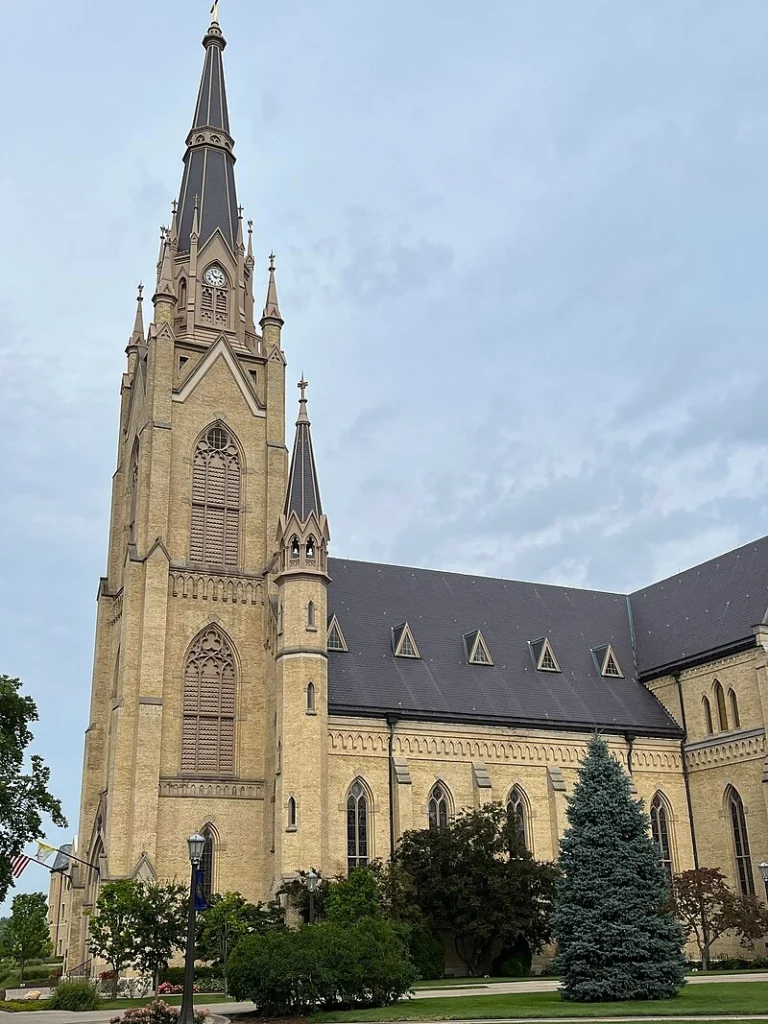
Architect(s) : Father Alexis Granger, Father Edward Sorin and Brother Charles Harding.
Architectural style : Gothic Revival architecture
Exterior
The church’s exterior is made of Notre Dame Brick and has a bell tower with two lateral pinnacles and a spire. The bell tower is 218 feet tall, and topped by 12 feet tall golden cross, making its total of 230 feet the tallest height on campus.
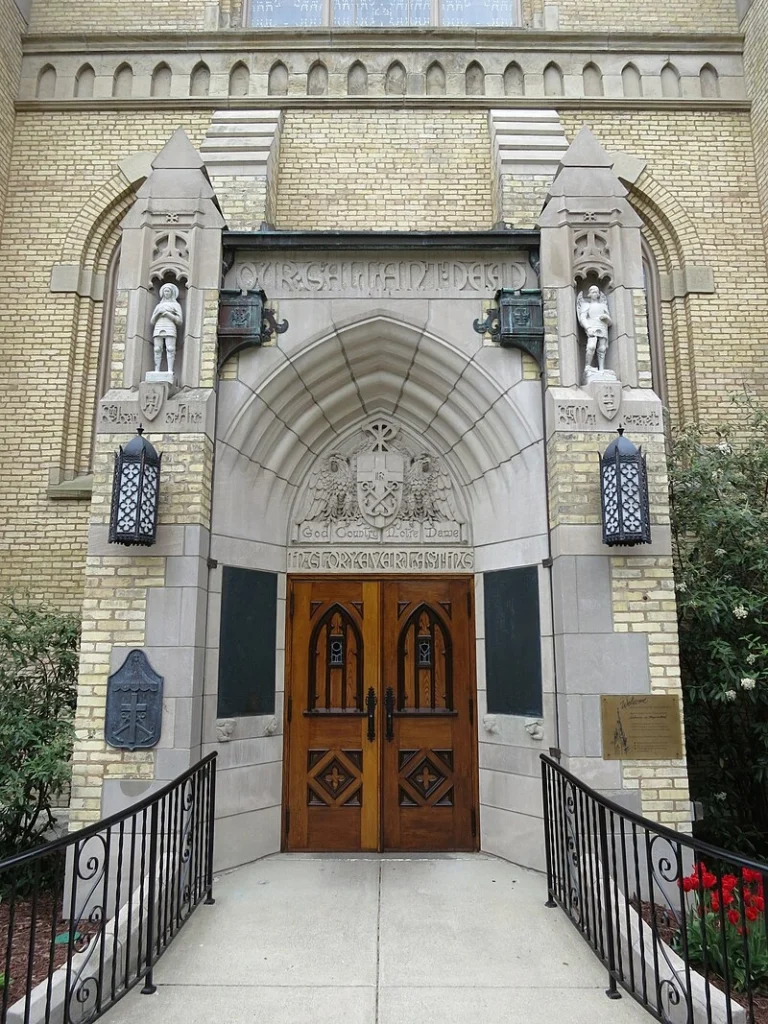
World War I Memorial Door
Plans for a memorial for Notre Dame’s contributions to World War I began in 1919 shortly after the Armistice. Funds were collected by the Notre Dame Service Club and the local chapter of the Veterans of Foreign Wars. A memorial door on the east transept of the basilica was designed by Notre Dame architects Vincent Fagan and Francis Kervick. The final design featured a door surmounted by a pointed arch and flanked by two buttresses, all in gothic style and yellow brick as the rest of the basilica. The memorial was initially intended to honor all 2,500 Notre Dame affiliates, including future presidents Rev. John Matthews Walsh and Rev. L. Charles O’Donnell, who had been chaplains in the military. However, later revisions to the plan reduced it to two plaques flanking the door and commemorating the 46 Notre Dame students, alumni, and faculty who died in combat. Two stained glass windows depicting the Tudor Rose and the Poppy line the oak door with iron hinges. The stone lintel topping the door is inscribed with the words “In Glory Everlasting”, while above the lintel a carved panel depicts two eagles supporting a shield with the old university seal (in use before 1930) and carrying in their claws a ribbon which the words “God, Country, Notre Dame.” The phrase “Our Gallant Dead” is carved into the stone facade above the door. Statues of Jean of Arc and St. Michael by Rev. John J. Bednar, CSC, were added to the niches in the buttresses above the door in 1944, during the a campus beautification project. The Rev. Matthew J. Walsh dedicated the World War I Memorial Door on Memorial Day 30 May 1924 with a military mass.
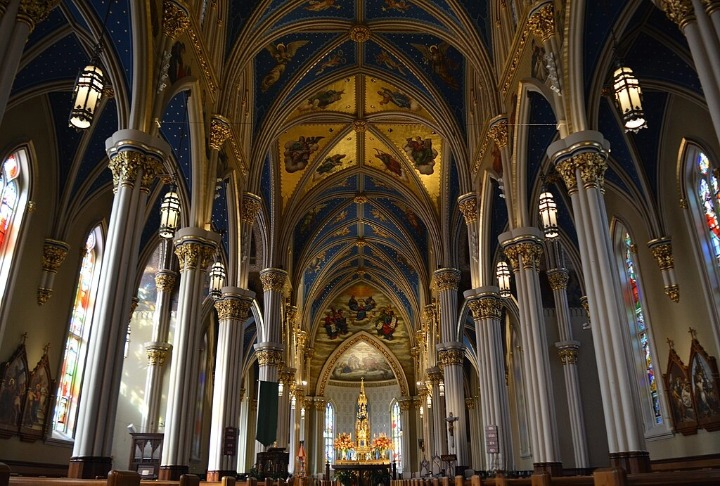
Interior
Altars
The basilica has three altars. The first is a graceful bronze Gothic Revival altar built in Froc-Robert’s Paris shops for the Centennial Exposition in Philadelphia, where it won a design award. Father Sorin bought the piece for the church after the Exposition. The tabernacle tower, which holds the reserved Blessed Sacrament, was inspired by Revelation 21:9, the vision of the new Jerusalem. The Gothic altar was moved to the apse following the Second Vatican Council, and a new altar was installed in the transept. This altar, called the Altar of Sacrifice, was made from old pews and choir stalls from the Lady Chapel. The third altar is a baroque altar in the Lady Chapel believed to come from the studios of Giovanni Bernini in Rome. Next to the gothic altar there are the Umbraculum and the Tintinnabulum, which are adorned with the insignia of the Pope and the coat of arms of the basilica, the dioceses, and the congregation. These two items represent the minor basilica designation. The baptismal font, which is located at the entrance of the church, dates from 1871.
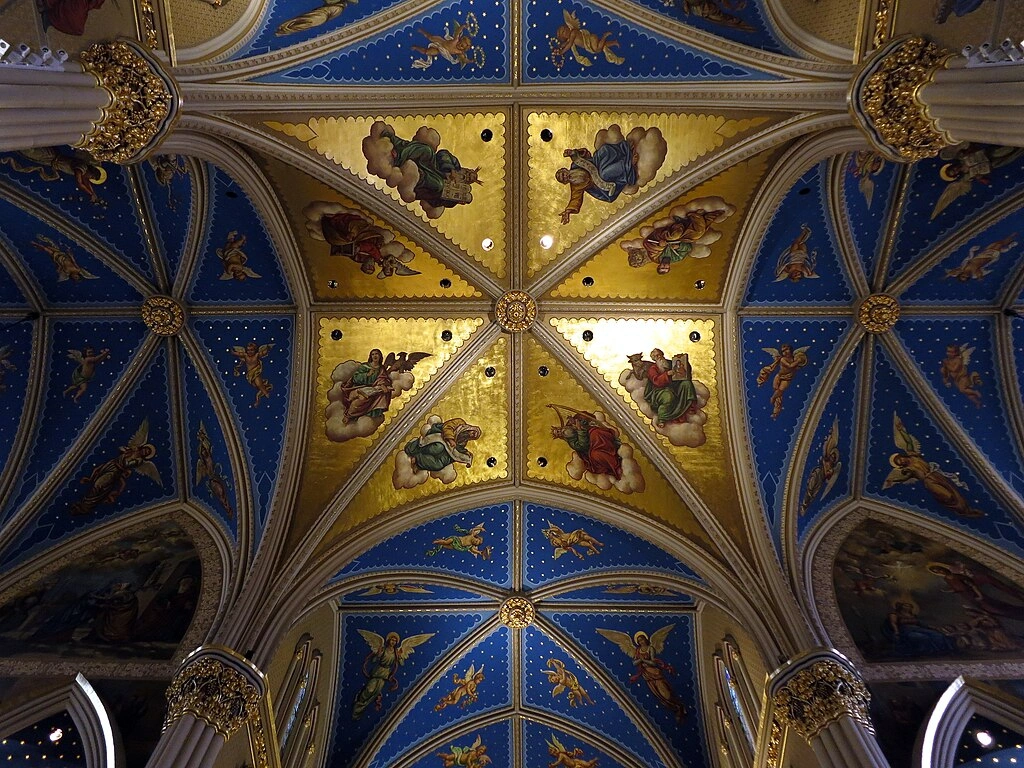
Frescoes
The frescoes adorning the walls and the ceilings of the nave were painted by Vatican painter and artist in residence Luigi Gregori. The ceilings are filled with a starry sky with angels, while the walls and transept are decorated with figures of saints. Each of the 12 bays of the vaulted veilinceuling is decorated with an angel, for a total of 96 painted angels. The stations of the Cross on the walls of the main nave were also painted by Gregori. The frescoes are in the same neogothic style as Santa Maria sopra Minerva, which was painted by Bernardino Riccardi, Pietro Gagliardi, Tommaso Greggia, and Raffaele Casnedi in the middle of the 18th century. This style was inspired by Italian gothic decorations, such as the Basilica of Saint Francis of Assisi or the Scrovegni Chapel. The saints depicted on the left side of the nave: Apollonia, Anthony, Bernard of Clairvaux, Dominic, Francis, Stanislaus Kostka, Aloysius Gonzaga, Rose of Lima, Agnes. On the right side of the nave: John the Baptist, John the Evangelist, Mary Magdalene, Saint Alexius, Benedict Joseph Labre, Thomas Aquinas, Saint Jerome, Saint Lucy, Saint Cecilia. On the left side of the choir the paintings of the Sacred Heart of Jesus, Gregory the Great, Ignatius of Loyola and on the right side of the choir: Immaculate Heart of Mary, Augustine of Hippo, Benedict of Nursia. At the crossing, the ceiling is gold instead of blue, marking the sanctuary of the church, and is adorned with the figures of the four evangelists and Old testament prophets: Isaiah holding a scroll, David with a harp, Jeremiah with a scroll, and Moses with the tablet of the law, plus the evangelists Matthew (angel), John (eagle), Luke (ox), and Mark (lion) from the New Testament. The Nativity of Mary, Presentation of Mary, Annunciation, Marriage of the Virgin, Visitation, Nativity of Jesus, and Mary Queen of Heaven are all depicted in the transept’s frescoes. The fresco at the entrance of the Lady Chapel depicts the Coronation of the Virgin Mary as Queen of Heaven and was devised in 1874 and painted in 1887. Mary is crowned with a tiara of roses by Christ and God the Father under a dove symbolizing the Holy Spirit; the group is surrounded by figures from the Old and New Testaments holding scrolls and quills. At the end of apse, on the left wall, there is a mural depicting apparition of Our Lady of Lourdes to Saint Bernadette in 1858 and on the right one a mural depicting the death of Saint Joseph. In the Lady Chapel, Gregori painted the luminous exaltation of the Cross, where the True Cross is exalted under the motto, Spes Unica. At the center of the fresco is the cross, supported by angels. A holy host carrying the instruments of Christ’s passion surrounds the cross. Saints and prophets are arranged all around: Behind Saint,St. Patrick is depicted. Mark, holding a clover, and was added by Gregori after requests from the student body to honor its Irish heritage. Saint Macarius, a Jerusalem bishop, and Saint Helena, Constantine’s mother, are depicted in the foreground. Macarius is credited with discovering the Cross in 325 AD.
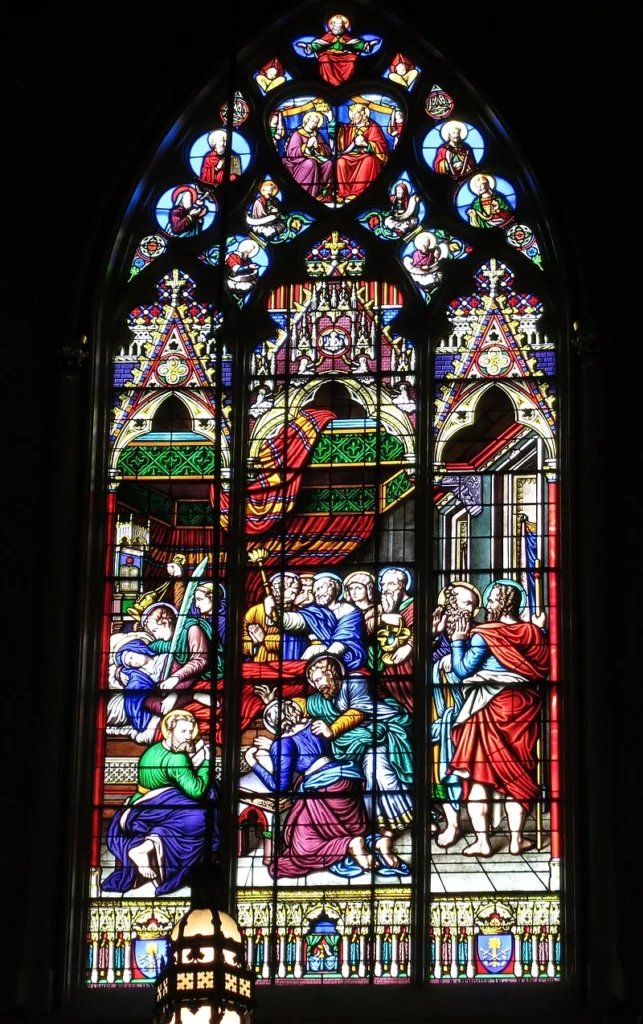
Windows
The Carmel du Mans Glassworks, which was first owned by Carmelite nuns in Le Mans, France, and then by Eugène Hucher and associates, designed and produced the 116 stained glass windows, which consist of more than 1,200 individual panels. The 44 large windows depict 114 life-size scenes and 106 smaller scenes. They were installed beginning in 1873, over a period of 15 years. The subjects of the windows were carefully chosen by Fr. Sorin with a pedagogic purpose, and the choice and positioning of the depicted figures is intentional and highly symbolic. Following Northern French custom, windows are read left to right, first the lower panel and then the upper. Sorin carefully selected the iconographic program for the church window. The large size of the order and the number of windows enabled such artistic and pedagogic program to be cohesive and planned out. The windows in each part of the church hosts a different theme: those of the narthex focus the mercy of God (featuring Purgatory and the Last Judgement), those of the nave feature saints, those of the transept regard the Church, and those in the sanctuary feature the most important saints of the Church. The chapels windows have a distinct and secondary message from that of the main body of the church, and each chapel focuses on a specific message or devotion. Each of the 16 windows in the nave and transepts depicts 4 saints for a total of 64 figures, and each window has a theme (for example 4 saints who were kings or 4 who were nuns). The fourth windows of the nave represent the Great Fathers: the window on the east side of the nave depicts the Eastern Church fathers: Basil of Caesarea, Gregory Nazianzus, Athanasius of Alexandria, John Chrysostom; the window on the west side represent the Western Church fathers: Augustine, Saint Jerome, Ambrose, Gregory the Great. The window on the north side of the west transept depicts the Sacred Heart of Jesus that inspired the basilica’s name, while another on the south side shows Father Sorin presenting the building to God. The windows in the Lady Chapel depict stories for Christ’s Life and each side chapel has its own theme that is depicted in its windows. The East and West transepts feature two large windows: the eastern window depicts the Pentecost, and its positioned towards the rising sun to symbolize rebirth, while the western transept depict the Dormition of Mary, and it is positioned towards the setting sun to symbolize the end of earthly life.

Side chapels
The Chapel of the Holy Cross with the Stations of the Cross contains the tomb of John Francis O’Hara, C.S.C., university president from 1934 to 1940 and the first member of the Congregation of Holy Cross named a cardinal. The Return of the Prodigal Son statue by Ivan Metrovi is also housed in the chapel. The windows depict six of the Stations of the Cross: Jesus takes up the cross, Jesus falls the first time, Jesus meets his afflicted mother, Jesus falls the second time, Veronica wipes the face of Jesus, Jesus falls the third time. The selection of these six among the fourteen stations is due to the chapel’s dedication to the cross itself. The crucifixion is not present, but all three times Jesus falls are, as well as his encounters Simon of Cyrene, his mother, and Veronica. A statue of Blessed Basil Moreau, C.S.C., founder of the Congregation of Holy Cross and beatified on September 15, 2007, can be found in the Chapel of Our Lady of Victory. The statue was sculpted by Robert Graham and contains a relic of Blessed Basil Moreau. It also hosts a copy of the ‘New Icon of the Martyrs and Witnesses to Faith of the Twentieth Century’, kept at San Bartolomeo all’Isola. Although the Notre-Dame-des-Victoires (Our Lady of Victories) church in Paris is a major place of devotion for Congregation of Holy Cross and Sorin had been there made pilgrimages, the original plan for the church did not include a chapel dedicated to Our Lady of Victories. However, Sorin was lost at sea in 1875 and he credited the providential rescue of the disabled and drifting ship to Our Lady of Victories and in September 1876, added this chapel dedication. The windows in the chapel depict stories connected to traditional stories of Mary’s intercession in history: two panels depict the Battle of Lepanto, the Battle of Las Navas de Tolosa, Louis XIII and the Siege of La Rochelle (during which the king is seen with a scroll with the plans for the construction of Notre-Dame-des-Victoires), the Plan of Notre-Dame-des-Victoires (in which the king agrees to finance the construction of the church for the Discalced Augustinians), Fr. Charles-Éléonore Dufriche-Desgenettes establishing the Archconfraternity of the Most Holy and Immaculate Heart of Mary (which was founded and revitalized the Notre-Dame-des-Victoires parish, and of which Sorin was a member), and finally then Our Lady of Victories with the Child Jesus above the globe of universe (as depicted in a statue in Notre-Dame-des-Victoires in Paris).
The Chapel of Holy Angels contains a framed modern painting of Our Lady of Guadalupe, painted by art professor Maria Tomasula in 2008. Michael, Raphael, and Gabriel are the three major biblical archangels depicted in the stained glass windows. They are shown in typical nineteenth century style, with feminine traits and incorporeal aspect, depicted on clouds and wearing fine garments and a circlet crown. The windows show Saint Michael the Archangel defeating Satan (with a picture of Mont-Saint-Michel in the background), the inspiration for Mont-Saint-Michel (with Michael appearing to Aubert of Avranches and telling him to build the monastery), Raphael freeing Peter, a guardian angel protecting a child, Gabriel’s nativity scene, and Gabriel’s nativity scene with Mary. The Lady Chapel is the largest and most prominent chapel in the center, behind the altar. In medieval cathedrals, the Lady Chapel was common, and it was also influenced by the one in St. Patrick’s Cathedral in New York. The main feature of the chapel is the statue of Mary. Under it, is a baroque altar believed to come from the studios of Giovanni Bernini in Rome, where Fr. Sorin found it during one of his trips. The tabernacle doors contain a fragment of wood which tradition says to be from a table on which St. Peter celebrated Mass in Rome. The chapel, also known as Sacred Heart Chapel and Chapel of the Exaltation of the Holy Cross (as depicted in the ceiling painted by Luigi Gregori), was added to the basilica in 1886 to help celebrate Fr. Sorin’s ordination in 1888. Stories from Jesus’ life and the biblical foundation for devotion to the Sacred Heart are depicted in the windows. The windows on the western side, read bottom to top, depict: The Birth of Jesus, The Last Supper, Gethsemane, The Crucifixion, The Pieta, The Risen Jesus and Doubting Thomas. The eastern windows depict the historical devotion to the Sacred Heart: Saint Margaret Mary Alacoque’s great apparition (who was really important in the development of the devotion to the Sacred Heart), Saint Margaret Mary Alacoque’s vision in the Filbert grove, the Consecration of the city of Marseille to the Sacred Heart (done by bishop Henri de Belsunce in response to the plague and an important step in the spread of the devotion), Pope Clement XIII proclaiming the devotion to the Sacred Heart in Poland in 1765, the homage of France to the Sacred Heart (a popular Catholic lithograph likely printed as part of the campaign for the construction of the Basilica of Sacré-Coeur, Paris), and finally founders of Sacred Heart devotion (which depicts Saints Bridget of Sweden, Teresa of Avila, Margaret Mary Alacoque, Bernard of Clairvaux, Francis de Sales, Augustine, Francis of Assisi, figures from history that contributed to the evolution of the devotion).
The Reliquary Chapel houses relics of the Twelve Apostles, a piece of the True Cross, the burial of St. Severa, in addition to numerous other items of worship. The wax figure is of St. Severa, a third century martyr. The cloth covered boxes at her head and feet contain her relics. Above the relic case is a copy of a portion of Raphael’s fresco, Disputation of the Holy Sacrament. The chapel also hosts a copy of the Bronze statue of Saint Peter in Saint Peter’s Basilica and a copy of the icon of Our Lady of Czestochova. The windows, installed in 1884, depict stories and miracles relating to the discovery or translation of relics. They show the translation of Saint Martin of Tours’ relics, the discovery of Saint Stephen’s relics, the translation of Saint Nicholas’ relics from Myra to Bari, King Louis IX carrying the Crown of Thorns in Paris, the 1602 return of Saint Eutropius’ relics from Bordeaux to Saintes (although this window has also been interpreted by some scholars as the relics of Augustine, and the translation of The Brother Andre Chapel, which houses a statue of Saint Andre Bessette, C.S.C., is dedicated to the first saint of the Congregation. He was canonized in 2010 for his work among the needy in Montreal. The chapel holds a statue of Saint André Bessette was designed by the Rev. C.S.C. Anthony Lauck (1985). The windows depict episodes about the life and devotion to Mary. They depict the Nativity of Mary (in typical fifteenth-century style), the presentation of Mary, the Assumption (including a fifth century tradition that when Mary’s sepulchre was opened it contained only flowers), the coronation of the Mary in Heaven, the proclamation of the Immaculate Conception (depicting Pope Pius IX proclaiming the dogma on 8 December 1854), and Mary as the Immaculate Conception with three angels. The Holy Family Chapel commemorates St. Joseph and hosts Ivan Meštrović’s masterpiece, the Pietà. The sculptor did the sketches for this magnificent pieta while he was a political prisoner of the Nazis. Mestrovic used his own likeness for Joseph of Arimathea. The work was exhibited at New York’s Metropolitan Museum of Art before going on display in the church in 1955. The Vatican Museums have a bronze copy, and the Ivan Metrovi Gallery in Split has a gesso copy. Stories about the Holy Family and the Nativity are shown in the chapel’s windows, with stories about Saint Joseph taken from apocrypha. They depict:the Selection of Joseph as Mary’s husband (from the Protoevangelium of James), the wedding of Joseph and Mary, the presentation of Jesus at the temple, Joseph Is warned by an angel to flee to Egypt, the Flight into Egypt, and the Death of Joseph.
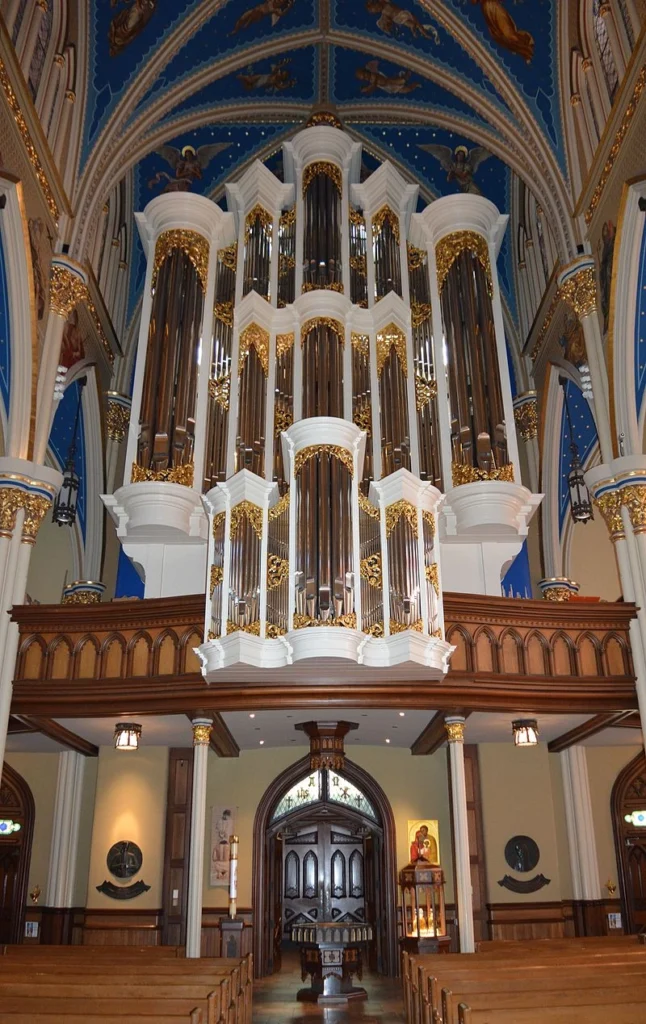
Organ
The first Sacred Heart Church had a small reed organ in the 1850s. Father Edward Sorin approved its replacement in 1865 with a 1,500-pipe hand-pumped organ. Derrick and Felgemeker of Erie installed a 2,000-pipe organ in the newly constructed but unfinished Sacred Heart Church in 1875. This organ was later moved inside the completed church. In 1961 university president Rev. M. Theodore The addition of 300 pipes to the organ was approved by Hesburgh. On 2 April 1978 a new organ was installed, donated by Marjorie O’Malley and built by the Holtkamp Organ Company of Cleveland, Ohio. It debuted at a dedication Mass celebrated by Hesburgh and a recital performed by Professor Michael Schneider of Cologne, Germany. In the fall of 1981, Professor Craig Cramer joined the Department of Music at Notre Dame and took over Calvin Bower’s task of creating the organ performance program. At the end of 2006, Dr. formed a committee led by Campus Ministry to look into replacing the basilica organ. Gail Walton, the basilica’s director of music since 1988. After conducting a nationwide search, the committee decided to give Paul Fritts the commission to build the new organ for Saint Joseph Cathedral in Columbus, Ohio, in December 2006. This was Fritts’ second commission from Notre Dame. In 2004, Paul Fritts and Company Organ Builders of Tacoma, Washington, completed a 35-stop organ that was also an O’Malley gift and was designed in the northern German tradition for the new DeBartolo Performing Arts Center’s Reyes Organ and Choral Hall. The Great Recession halted the project by taking a hit on the university endowment and benefactions, and the idea of replacing the basilica organ was tabled indefinitely. The project was further dealt a blow by the death of its foremost champion Gail Walton in February 2010. However, the university approved a plan to commission a new organ for the basilica in the fall of 2010 and began the search for a donor. As decided previously, organ maker Paul Fritts was commissioned for the project, and initial design work began in 2012 with work on the case in Tacoma beginning in 2013. The project called for a four-manual instrument with 70 stops, 5,164 pipes, and a case that was based on Dutch masterpieces. It was to be Fritts’s greatest creation. The basilica closed in Christmas 2013 for the first phase of the organ project, which included a 44-day replacement of the church carpeting with 25,000 slate-colored porcelain tiles to improve acoustics. Meanwhile, a third Fritts commission, sponsored by Denis ’67 and Susan McCusker, saw a studio organ designed in 2014 for the Walton Choir Rehearsal Hall in Coleman-Morse Center. On 28 December 2015 the Holtkamp organs played its last song, Silent Night, before its dismantling started the next morning. The organ pipes were donated to the reconstruction of a local parish, Saint Pius X in Granger, Indiana. In October 2015, Fritts loaned the church a temporary organ once the Holtkamp was removed. The concrete of the choir loft was reinforced, and steel support structures for the foundation were added. The basilica choirs sang in the west transept next to the interim organ during the installation of the new organ. On Sunday, July 31, 2016, the brand-new organ, which bears the names of the donors Wayne and Diana Murdy, arrived at the basilica on two tractor-trailers. By end of August 2016, the façade and case was completed, and Fritts Company began the process of tuning and voicing the pipes and connecting the organ’s key action, stop action, windworks and electrical wiring. On October 6, the organ was put through its first full performance test during the annual Blue Mass to honor police, firefighters, and emergency medical personnel. In the weeks that followed, the last rank of pipes were tuned. It was finished on schedule for Christmas 2016. The new four-manual 70-stop Murdy Family Organ was designed and built by Paul Fritts & Company Organ Builders as its Opus 37. It has 4 keyboards, 70 stops and 5,164 pipes and stands 40 feet high and weighs more than 20 tons. Workers were required to reinforce the loft in order to support the larger instrument prior to installation. Bishop Daniel Jenky returned to campus to dedicate the instrument on 20 January 2017 which featured a recital by university professor and organist Craig Cramer.
Basilica museums
The basilica’s museum, located behind the sacristy, displays artifacts from the history of the university and the Congregation of Holy Cross. Many items belonged to Fr. Edward Sorin, founder of the university. Items on display also include liturgical vessels and chalices, personal effects of Luigi Gregori, a cassock that belonged to Pope Paul VI, chalices and cassock of Pope Pius IX, and a six-foot- high processional cross presented to Notre Dame by Napoleon III and Empress Eugenie. A papal tiara from the 1850s that Pope Pius IX gave to Edward Sorin is especially significant. It is only one of two in existence outside the Vatican, and of these two the only traditional one, the other being the modernist tiara of Paul VI. The Bishop’s Museum is in the basement, and it has pontificalia from the 19th century of various American bishops. It houses mitres, shoes, caps, sandals, sashes, gloves, Cardinals’ galeros, chalices, and vestments that the daughter of the Empress of Austria embroidered. Among these is Rev. The sick-call satchel of Alexis Granger, which contained oils to anoint the sick; the crosier and pectoral cross of the Reverend John Carroll, who was the first Catholic bishop of the United States; and a gold screen from the Santa Brigida sanctuary through which St. Bridget of Sweden used to hear Mass; mitre of bishop Michael Francis Egan (first bishop of Philadelphia); crosier, mitre, and rabbi used by cardinal John McCloskey, first bishop of Albany; maniple from 1840 of the first bishop of California, Francisco García Diego y Moreno; cassock and books written by and about Archbishop Marcos G. McGrath, CSC.
Liturgies
The basilica is the main liturgical center for the university community. During breaks and twice during the day when classes are in session, mass is celebrated. Each weekend there are three Sunday masses celebrated for students, faculty, staff and community members. The basilica is a popular place for weddings of Notre Dame alumni, hosting several weddings each Saturday, whenever the Fighting Irish do not have a home football game. The Congregation of Holy Cross has also held final professions and ordination masses at the basilica, as well as funerals for members of the religious community and alumni. Every Sunday evening, the basilica holds Solemn Vespers and a special Advent service called Lessons and Carols. Stations of the Cross is celebrated each Friday during the season of Lent. The basilica also hosts a variety of special liturgies at other times of the year. The Paschal Triduum is celebrated every Easter and it lasts from Holy Thursday with the celebration of the Last Supper until Easter Sunday with Vespers. Students and locals alike enjoy these celebrations, and Easter liturgies always draw a large crowd. Located in the Crypt Church (basement level) of the basilica is Sacred Heart Parish. Two people are buried in the basilica: Cardinal John Francis O’Hara, who is buried in the Chapel of the Holy Cross, and Orestes Brownson, who is buried in the crypt.
Carillon
The original 23 bells were installed in 1856 and make-up the oldest carillon in North America. They were made in France, and each has a name related to Mary. The final bell, which is one of the grandest in the United States was blessed in 1888, during Father Sorin’s Golden jubilee and it is named for St. Anthony of Padua, it is an immense non swinging bourdon, more than seven feet tall and weighing 15,400 pounds.
Feast Day
Feast Day : Friday after the second Sunday after Pentecost
The Basilica of the Sacred Heart at Notre Dame in Indiana celebrates its feast day on the Solemnity of the Most Sacred Heart of Jesus. This feast takes place each year on the Friday after the second Sunday after Pentecost, which is about 68 days after Easter. Because of this, the date changes yearly but always falls in late May or June. As the basilica is named for the Sacred Heart, this day holds special meaning and is marked with liturgical celebrations and devotion.
Church Mass Timing
Monday to Friday : 11:30 AM, 5:15 PM.
Saturday : 05:00 PM.
Sunday : 10:00 AM, 12:00 PM, 3:30 PM, 8:30 PM.
Church Opening Time:
Monday to Sunday : 9:00 AM, 9:00 PM
Contact Info
Address : Basilica of the Sacred Heart
101 Basilica Dr, Notre Dame, IN 46556, United States
Phone : +1 574-631-7329
Accommodations
Connectivities
Airway
Basilica of the Most Sacred Heart, Notre Dame, Indiana, USA, to South Bend International Airport, distance between 14 min (5.7 mi) via US-20 Business W.
Railway
Basilica of the Most Sacred Heart, Notre Dame, Indiana, USA to Amtrak Station, distance between 12 min (4.8 mi) via Holy Cross Dr.


